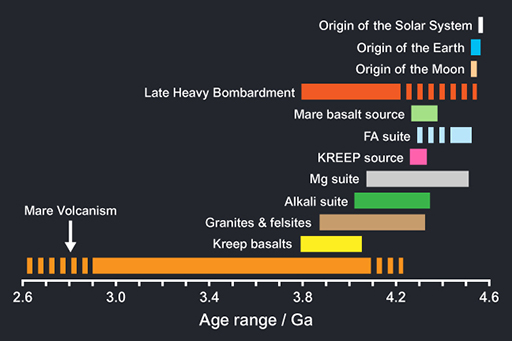3.6 History of the Moon
When combined with isotopically dated samples from known areas, the Apollo landing sites for instance, it has been possible to estimate an absolute age for an area from crater counting using the kind of size–frequency distribution that you saw in the previous step. This way, it is possible to estimate ages for areas for which samples are unavailable and a full history of the Moon can be inferred.
The history starts with the giant impact, the most commonly accepted current hypothesis for lunar origin. As you have seen, after accretion, the Moon was in a state called a magma ocean, which means that a significant portion of the Moon’s rock was molten.
Dating of these two lithologies in the samples gives a highland crust formation that would have started 4.56 Ga ago (where 1 Ga is 1 billion years). The youngest basalts associated with the main crust-forming events have an age of around 3.8 Ga.
Lunar mare volcanism took place after the formation of the highland crust. The volcanic eruption filled basins in the crust where it was made thinner; filling impact basins for instance. The oldest mare basalt dated isotopically is 4.23 Ga old while the youngest is 2.7 Ga old. On the basis of remote-sensing data stratigraphy and crater density, a younger age of 1.5 Ga has been suggested for the eruption of mare basalts in Oceanus Procellarum.
Thus mare volcanism overlapped with the end of crust formation and may have continued up to 1.5 Ga ago, which marked the end of volcanic activity on the Moon but not the end of its story.
The ages of polymict breccias, which are related to impacts on the Moon, cluster noticeably around 3.9 Ga. This means that prior to this time or at this time only, the impact rate was far higher than it is today. Such a clustering of ages is also observed on other planets or asteroids in the Solar System, most notably on Mars and the asteroid Vesta. This event, the Late Heavy Bombardment, was spread across the Solar System and not just localised on the Moon. The cratering rate decreased rapidly after this bombardment, by an order of 10 between 3.9 and 3.1 Ga ago. Impactors have continued to shape the surface of the Moon in more recent times, forming younger craters. Among the notable younger craters are Copernicus (1.0 Ga) and Tycho (0.3 Ga).

